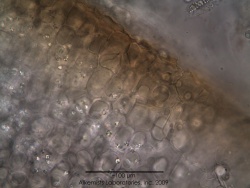Cuminum cyminum (seed)
(Created page with '=Introduction= =Macroscopic Entries= =Microscopic Entries= =HPTLC Entries= =Other Points of Interest= Category:blank') |
(add askbox) |
||
| (8 intermediate revisions by 3 users not shown) | |||
| Line 1: | Line 1: | ||
| − | = | + | {{DISPLAYTITLE:''Cuminum cyminum'' (seed) }} {{askbox|herb=''Cuminum cyminum''}} |
| − | = | + | =Nomenclature= |
| − | = | + | |
| − | = | + | {{nomenclature | binomial=Cuminum cyminum |
| − | = | + | |authority=L. |
| − | [[ | + | |family=Apiaceae |
| + | |scn=cumin | ||
| + | |syn=jiraka | ||
| + | |ayurvedic= | ||
| + | |pinyin= | ||
| + | |aka= | ||
| + | |notes= }} | ||
| + | |||
| + | =Botanical Voucher Specimen= | ||
| + | =Organoleptic Characteristics= | ||
| + | {| border=1 | ||
| + | | | ||
| + | {{Organolepsy | source=United States Dispensatory (1918) | ||
| + | | description=[The cumin fruits (''seeds'')] odor is peculiar, strong, and heavy; their taste warm, bitterish, aromatic, and disagreeable.}} | ||
| + | |} | ||
| + | =Macroscopic Characteristics= | ||
| + | {| border=1 | ||
| + | | | ||
| + | {{Macroscopy | source=United States Dispensatory (1918) | ||
| + | | description=''Cuminum Cyminum'' L. is an annual umbelliferous plant. | ||
| + | The cumin fruits (''seeds'') are elliptical, flat on one side, convex, furrowed, and rough on | ||
| + | the other, from 5 to 6 mm. in length and about 1.5 mm. in thickness, and of a light | ||
| + | brown color. Each has seven longitudinal ridges. Two mericarps are sometimes seen | ||
| + | united. [...] They contain about 2.5 per cent. of an essential oil, which | ||
| + | is lighter than water, yellowish, and has the sensible properties of the fruits.}} | ||
| + | |} | ||
| + | =Microscopic Characteristics= | ||
| + | {{Media |cat=Microscopy | source=Elan M. Sudberg, Alkemist Laboratories | ||
| + | | companyimage= AP-LOGO-Laboratories Crop - Copy.jpg | ||
| + | | companyURL=http://www.Alkemist.com | ||
| + | | mainimage=Cuminum cyminum - Alkemist Laboratories.jpg | ||
| + | | caption1=Endosperm showing small rosettes of calcium oxalate observed at 400x with Acidified Chloral Hydrate Glycerol Solution. | ||
| + | | description= Cumin (seed) (''Cuminum cyminum L.'') | ||
| + | | reference=Medicinal Spices, Teuscher, E., 2006, CRC Press | ||
| + | | }} | ||
| + | |||
| + | =High Performance Thin Layer Chromatographic Identification= | ||
| + | |||
| + | =Supplementary Information= | ||
| + | =Sources= | ||
| + | <references /> | ||
Latest revision as of 19:28, 2 June 2014
Contents |
Nomenclature
Cuminum cyminum L. Apiaceae
Syn. jiraka
Standardized common name (English): cumin
Botanical Voucher Specimen
Organoleptic Characteristics
|
Macroscopic Characteristics
|
Microscopic Characteristics
 |
|
|
High Performance Thin Layer Chromatographic Identification
Supplementary Information
Sources
- ↑ United States Dispensatory (1918)
- ↑ United States Dispensatory (1918)
- ↑ Elan M. Sudberg, Alkemist Laboratories http://www.Alkemist.com
